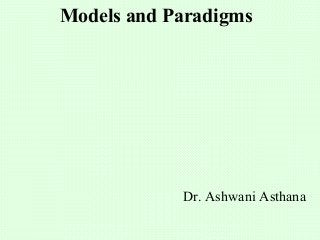
- Models and Paradigms In Archaeology
- 1. Models and Paradigms Dr. Ashwani Asthana
- 2. Models and Paradigms Model : • Orientation in an investigation • Archaeologist’s explanation may be ecology- oriented or diffusion-oriented, something else oriented, etc, according to his perspective • Taxonomical • Some designate, these different orientation as models eg. Colin Renfrew’s framework model. Bruce Trigger’s Processual model
- 3. Actual meaning of the term ‘model’: 1. Two fundamental notions embedded (i) Isomorphism (ii) Idealization 2. Models are conceptual structures that (a) organise and guide our thinking (heuristic- serving or leading to find out; encouraging the desire to find out depending upon assumption based on past experience), (b) describe the relationship between variables (explanatory or legal), or (c) describe a situation in graphic form (illustrative)
- 4. 3. Models are not mysterious. We all use them in every day life Paradigm (Greek): literally meaning example showing certain pattern 1. Robert Metron in 1949 was the first to introduce the word to the scientific area by using it 2. Thomas S.Kuhn (1962) popularised the word and discussed in detail the nature and role of paradigm with the context and its effect with the change in nature and context
- 5. 3. David Clarke further utilised the role of paradigm in archaeology by the way of his field investigations and publishing works like Archaeology as Anthropology (1962) and Analytical Archaeology(1968) 4. It is very unfortunate that he died at the age of 36 but his various papers are remarkable for illustrating the application of new methodology in archaeology which are shining models of British scholarship
- 6. 5. Like Binford his work is also written in jargon which according to him is inevitable when scientific mythology is employed in any discipline (1979) • He commented that ‘yesterdays jargon is tomorrow's prose’. • Through his experience and field research he gives the clearest possible exposition of new archaeology, which according to him consists of:
- 7. 1. Morphological paradigm 2. Ecological paradigm 3. Anthropological paradigm 4. Geographical paradigm
- 8. 1. Morphological Paradigm 1. It consists of detailed study of artefacts assemblages using computer techniques 2. David Clarke successfully applied this approach is archaeological situation. • The technique involved with numeral, statistical and taxonomical data identifies fundamental archaeological entities (attributes or traits)
- 9. • These entities are linked together on the basis of hierarchy of various taxonomical ranks, eg., artefacts, types, industry, assemblages, cultures, and group of cultures • These entities are conceived as system in which the lowest place is assigned to the attributes of artefacts • Starting from the most basic unit, i.e., attributes, artefacts are defined as clusters of attributes; assemblages as clusters of industries; cultures as clusters of assembleges and culture groups as clusters of cultures
- 10. 3. Using computer techniques and employing the methods of numerical and statistical taxonomy, phase pattern regularities, time pattern regularities and system pattern regularities of archaeological entities are identified and analysed. 4. David Clarke used this approach for his dissertation on the Origin and Development of British Beaker Pottery
- 11. 2. Ecological Paradigm 1. Aims at reconstructing the dynamics of ecological equilibrium which existed between the prehistorical people and their changing environmental contexts • This approach has most remarkably been followed by David Clarke in his work Mesolithic Europe – The Economic Basis 1979 2. Earlier Senior Clarke (Graham) had postulated that the Mesolithic economy was based mainly on hunting fishing
- 12. 3. But it was refuted by David Clarke who on the basis of a variety of evidences, convincingly established that 80% of the subsistence of Mesolithic Europe was based on vegetal food. • This was supplemented by hunting and fishing • His observation was based upon the functional analysis of microlithic blade tools • Similar experimentations were carried out at Baghor in M.P.
- 13. 3. Anthropological Paradigm 1. It derives it models mainly from ethnology 2. It is not a new paradigm at all and is being utilized by prehistorians since the beginning of the discipline itself 3. The hypothetico – deductive procedure, characterises the new anthropological paradigm of archaeology 4. David clarke reexamined the evidence from Glastonbury excavation of early 20th century
- 14. • He identified various structures and located different activity areas • He reinterpreted the data on the basis of spatial, structural and artefact relationship and successfully traced the development of the site • He could identify in each complex the major house, minor house, temporary shelter or hut, granaries, stable, etc. 5. The study began with a typological analysis of buildings on the sites and a structural analysis of their relationship
- 15. 5. This procedure resulted in the identification of male and female activity areas, the socio-economic position of the occupants, etc. • From this, study expanded to consider the site in regional context 6. The work is remarkable for showing that how far-reaching conclusion can be drawn
- 16. Geographical Paradigm 1. Borrows its models mainly from modern geography or new geography • It emphasises the study of within site and between sites phase pattern regularities 2. The concept of site exploitation territory is one of the basic concepts in this paradigm
- 17. 3. David Clarke’s work on ‘spatial information in Archaeology is a superb example of geographical paradigm showing how far data can be interpreted by the way of obtaining information from spatial relationship • This approach has also been applied on various archaeological sites, eg., Jorwe early-late phase
